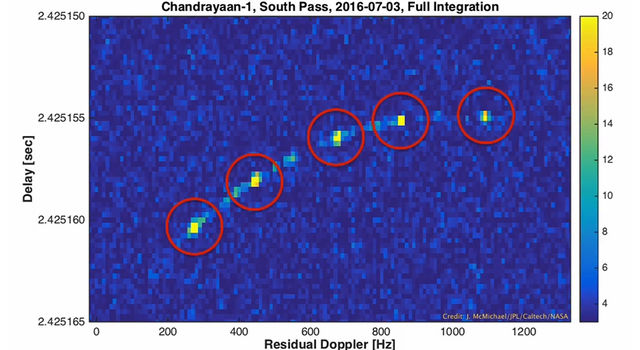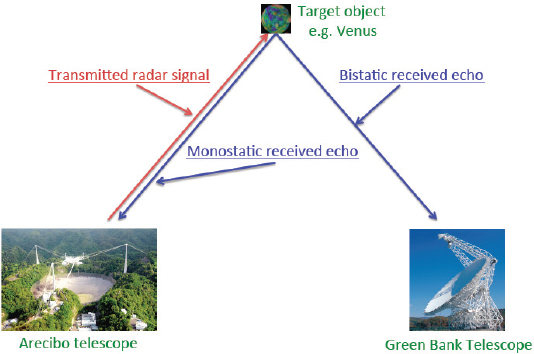 |
| Range-Doppler Plot of Chandrayaan-1 Radar Return |
| Goldstone Ground Based Radar Antenna |
NASA finds missing LRO, Chandrayaan-1 lunar orbiters
NASA's Jet Propulsion Laboratory said it has located its Lunar Reconnaissance Orbiter and India's Chandrayaan-1 spacecraft after disappearing for years.
"Hunting down LRO and rediscovering Chandrayaan-1 have provided the start for a unique new capability. Working together, the large radar antennas at Goldstone, Arecibo and Green Bank demonstrated that they can detect and track even small spacecraft in lunar orbit," JPL said in a statement. "Ground-based radars could possibly play a part in future robotic and human missions to the moon, both for a collisional hazard assessment tool and as a safety mechanism for spacecraft that encounter navigation or communication issues."
JPL said scientists found the spacecrafts orbiting the moon by using a new technological application [News | New NASA Radar Technique Finds Lost Lunar Spacecraft] found on ground-based interplanetary radar using signal configurations shown in the table below, previously used for exploration of Venus and near earth asteroid tracking. To find a spacecraft 237,000 miles (380,000 kilometers) away, JPL's team used NASA's 70-meter (230-foot) antenna at NASA's Goldstone Deep Space Communications Complex in California to send out a powerful beam of microwaves directed toward the moon. Then the radar echoes bounced back from lunar orbit were received by the 100-meter (330-foot) Green Bank Telescope in West Virginia.
Finding a derelict spacecraft at lunar distance that has not been tracked for years is tricky because the moon is riddled with mascons (regions with higher-than-average gravitational pull) that can dramatically affect a spacecraft's orbit over time, and even cause it to have crashed into the moon. JPL's orbital calculations indicated that Chandrayaan-1 is still circling some 124 miles (200 kilometers) above the lunar surface, but it was generally considered "lost."
However, with Chandrayaan-1, the radar team utilized the fact that this spacecraft is in polar orbit around the moon, so it would always cross above the lunar poles on each orbit. So, on July 2, 2016, the team pointed Goldstone and Green Bank at a location about 100 miles (160 kilometers) above the moon's north pole and waited to see if the lost spacecraft crossed the radar beam. Chandrayaan-1 was predicted to complete one orbit around the moon every two hours and 8 minutes. Something that had a radar signature of a small spacecraft did cross the beam twice during four hours of observations, and the timings between detections matched the time it would take Chandrayaan-1 to complete one orbit and return to the same position above the moon's pole.
The team used data from the return signal to estimate its velocity and the distance to the target. This information was then used to update the orbital predictions for Chandrayaan-1.
"It turns out that we needed to shift the location of Chandrayaan-1 by about 180 degrees, or half a cycle from the old orbital estimates from 2009," said Ryan Park, the manager of JPL's Solar System Dynamics group, who delivered the new orbit back to the radar team. "But otherwise, Chandrayaan-1's orbit still had the shape and alignment that we expected." Radar echoes from the spacecraft were obtained seven more times over three months and are in perfect agreement with the new orbital predictions. Some of the follow-up observations were done with the Arecibo Observatory in Puerto Rico, which has the most powerful astronomical radar system on Earth.
The Arecibo Observatory in Puerto Rico, which is operated by the National Science Foundation with NASA funding, and has the most powerful astronomical radar system on Earth, conducted follow-up observations.
 |
| Lunar Reconnaissance Orbiter (LRO) Spacecraft |
LRO is a robotic mission that set out to map the moon's surface. LRO and the Lunar CRater Observation and Sensing Satellite (LCROSS) were launched on an Atlas V rocket on June 18, 2009. LRO spent its first three years in a low polar orbit collecting detailed information about the moon and its environment. After this initial orbit, LRO transitioned to a stable elliptical orbit, passing low over the lunar south pole. With a suite of seven powerful instruments.
"Finding LRO was relatively easy, as we were working with the mission's navigators and had precise orbit data where it was located," Marina Brozovic, a radar scientist at JPL, said in a statement. "Finding India's Chandrayaan-1 required a bit more detective work because the last contact with the spacecraft was in August of 2009."
| Chandrayaan spacecraft a cube of side 1.5 m based on the
I-1-K bus used in the IRS series of satellites. It also carried the Moon Impact Probe which landed on the moon on November 14, 2009. |
Chandrayaan-1, a five-foot cube, was India's first mission to the Moon, launched on October 22, 2008 from SDSC SHAR, Sriharikota. The spacecraft was orbiting around the Moon at a height of 100 km from the lunar surface for chemical, mineralogical and photo-geologic mapping of the Moon. The spacecraft carried 11 scientific instruments built in India, USA, UK, Germany, Sweden and Bulgaria.
After the successful completion of all the major mission objectives, the orbit has been raised to 200 km during May 2009. The satellite made more than 3400 orbits around the moon and the mission was concluded when the communication with the spacecraft was lost on August 29, 2009.
JPL, which is located in the California Institute of Technology, said scientists found Chandrayaan-1 about 124 miles above the moon's surface, but the spacecraft is considered lost. The spacecraft is more than 230,000 miles away.
TABLE Current U.S. Planetary Radar Systems
| Transmitting Location | Frequency (GHz) | Bandwidth (MHz) | Power (MW) | Receive Location |
| Arecibo, Puerto Rico | 2.380 | 20 | 1.0 (CW) | Arecibo, Puerto Rico GBT, Green Bank, West Virginia VLA, Socorro, New Mexico LRO, Lunar orbit |
| 0.430 | 0.6 | 2.5 (pulsed) | Arecibo, Puerto Rico GBT, Green Bank, West Virginia | |
| Goldstone, California DSS-14 | 8.560 | 50 | 0.5 (CW) | Goldstone, California GBT, Green Bank, West Virginia Arecibo, Puerto Rico VLA, Socorro, New Mexico 10 VLBA sites |
| Goldstone, California DSS-13 | 7.190 | 80 | 0.08 (CW) | Goldstone, California GBT, Green Bank, West Virginia Arecibo, Puerto Rico |
Related/Background:
- Lunar Orbital Data Explorer - Home Page
- News | New NASA Radar Technique Finds Lost Lunar Spacecraft
- 6 Planetary Radar Astronomy | A Strategy for Active Remote Sensing Amid Increased Demand for Radio Spectrum | The National Academies Press
- Long Lost Indian Moon Probe Found by Earth-Based NASA Radar
- How NASA found India's long-missing moon probe
- NASA Radar Finds India's Lost Chandrayaan-1 Lunar Spacecraft - SpaceRef
- NASA’s interplanetary radar spots tiny derelict satellite in forgotten lunar orbit | TechCrunch

No comments:
Post a Comment